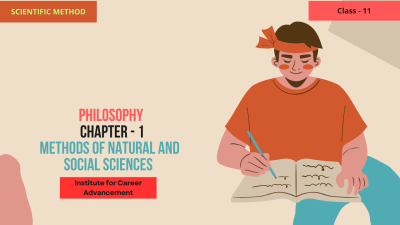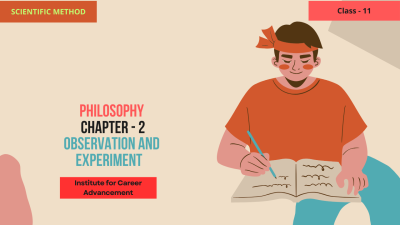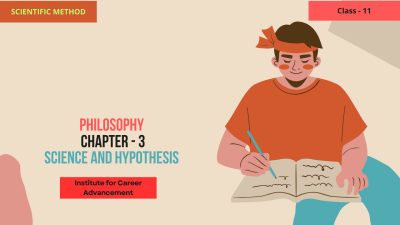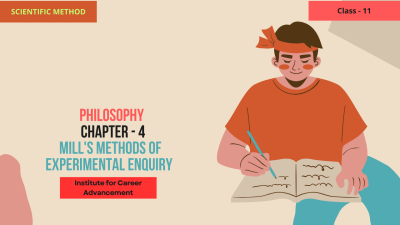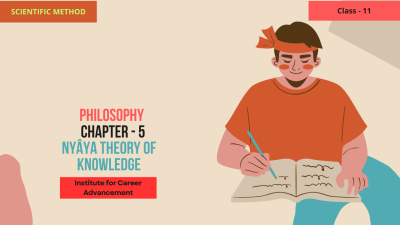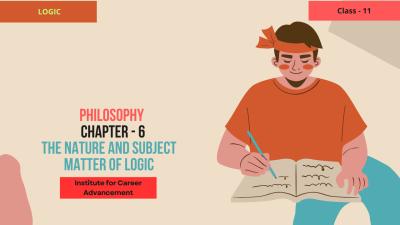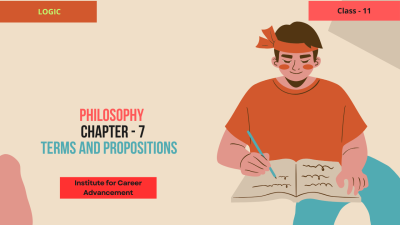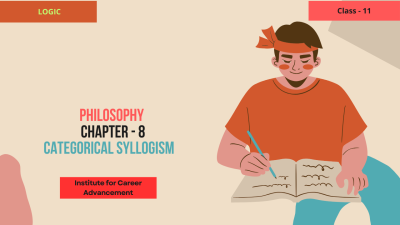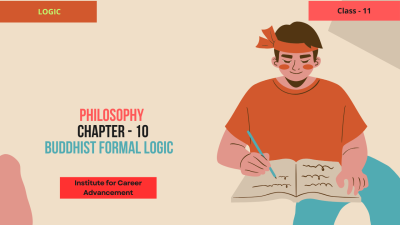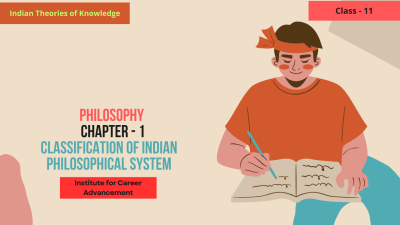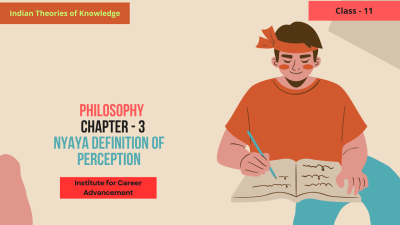Course description
The topic "Relations Between Propositions - Square of Opposition, Existential Import" in Class 11 Logic introduces students to the relationships between different types of propositions and how they interact logically. This is essential for understanding the structure of logical arguments and the reasoning behind the classification of propositions. Here's an overview of the key concepts covered:
1. Square of Opposition
The Square of Opposition is a diagram that shows the logical relationships between four types of categorical propositions. These propositions are used to express relationships between a subject and a predicate, and their interactions are visualized in the square. The propositions in the square are categorized by their quality (affirmative or negative) and quantity (universal or particular).
Types of Propositions in the Square of Opposition:
A (Universal Affirmative): "All S are P" (e.g., All humans are mortal.)
E (Universal Negative): "No S are P" (e.g., No humans are immortal.)
I (Particular Affirmative): "Some S are P" (e.g., Some humans are doctors.)
O (Particular Negative): "Some S are not P" (e.g., Some humans are not doctors.)
Key Relations in the Square of Opposition:
Contradictory Propositions: Two propositions are contradictory if they cannot both be true and cannot both be false. For example, A ("All S are P") and O ("Some S are not P") are contradictory.
Contradictory pairs: A ↔ O and E ↔ I.
Contrary Propositions: Two propositions are contrary if they cannot both be true, but they can both be false. For example, A ("All S are P") and E ("No S are P") are contrary.
Contrary pairs: A ↔ E.
Subcontrary Propositions: Two propositions are subcontrary if they cannot both be false, but they can both be true. For example, I ("Some S are P") and O ("Some S are not P") are subcontrary.
Subcontrary pairs: I ↔ O.
Subalternation: A relation where the truth of a universal proposition (A or E) implies the truth of its corresponding particular proposition (I or O), but not the reverse. For example, if A ("All S are P") is true, then I ("Some S are P") must also be true. However, the truth of I does not guarantee the truth of A.
Subalternation relations: A ↔ I and E ↔ O.
Purpose of the Square of Opposition:
Helps students understand how different types of categorical propositions relate to each other.
Facilitates logical reasoning by showing which propositions can or cannot be true together.
Provides insight into the structure of deductive reasoning.
2. Existential Import
Existential Import refers to the assumption that a proposition asserts the existence of the subject it refers to. This concept is particularly relevant for categorical propositions, as some types of propositions imply the existence of certain objects or individuals, while others do not.
Existential Import in Different Types of Propositions:
Universal Propositions (A and E):
Traditionally, universal affirmative (A) and universal negative (E) propositions were assumed to not have existential import in classical logic. This means a statement like "All unicorns are magical" does not assert the existence of unicorns, only that if they exist, they possess the property of being magical.
In modern logic, however, there is often a shift, and universal propositions can sometimes be interpreted as having existential import, meaning that the existence of the subject is implied.
Particular Propositions (I and O):
Particular affirmative (I) and particular negative (O) propositions are understood to have existential import. For example, "Some dogs are black" implies that there are some dogs that exist.
Importance of Existential Import:
Helps in evaluating the truth of propositions, especially when dealing with categorical syllogisms.
Affects how one interprets universal statements, particularly in contexts where the existence of the subject is questioned (e.g., non-existent or hypothetical entities).
Clarifies the assumption that a universal statement makes about the existence of its subject.
3. Course Goals and Learning Outcomes
By the end of this topic, students should be able to:
a. Understand the Square of Opposition
Identify the four types of categorical propositions: A, E, I, O.
Interpret the relationships between these propositions using the Square of Opposition.
Distinguish between contradictory, contrary, subcontrary, and subalternating propositions.
Apply the Square of Opposition to evaluate logical arguments and infer relationships between propositions.
b. Grasp the Concept of Existential Import
Understand what existential import means and how it applies to different types of propositions.
Recognize how existential import affects universal and particular propositions, particularly in categorical syllogisms.
Evaluate how the existence of subjects in a proposition impacts its truth value.
c. Apply These Concepts to Logical Reasoning
Analyze categorical syllogisms and determine the relationships between propositions.
একাদশ শ্রেণিতে বিষয় "প্রস্তাবগুলির মধ্যে সম্পর্ক-বিরোধীদের বর্গক্ষেত্র, অস্তিত্বগত গুরুত্ব" লজিক শিক্ষার্থীদের বিভিন্ন ধরনের প্রস্তাবের মধ্যে সম্পর্ক এবং তারা কীভাবে যৌক্তিকভাবে যোগাযোগ করে তার সাথে পরিচয় করিয়ে দেয়। যৌক্তিক যুক্তির কাঠামো এবং প্রস্তাবের শ্রেণিবিন্যাসের পিছনে যুক্তি বোঝার জন্য এটি অপরিহার্য। এখানে অন্তর্ভুক্ত মূল ধারণাগুলির একটি সংক্ষিপ্ত বিবরণ দেওয়া হলঃ 1টি। বিরোধী স্কোয়ার বিরোধী স্কোয়ার হল একটি চিত্র যা চার ধরনের শ্রেণীগত প্রস্তাবের মধ্যে যৌক্তিক সম্পর্ক দেখায়। এই প্রস্তাবগুলি একটি বিষয় এবং একটি ভবিষ্যদ্বাণীর মধ্যে সম্পর্ক প্রকাশ করতে ব্যবহৃত হয় এবং তাদের মিথস্ক্রিয়া বর্গক্ষেত্রে দৃশ্যমান হয়। বর্গক্ষেত্রের প্রস্তাবগুলি তাদের গুণমান (ইতিবাচক বা নেতিবাচক) এবং পরিমাণ (সর্বজনীন বা বিশেষ) দ্বারা শ্রেণীবদ্ধ করা হয়। বিরোধী স্কোয়ারের প্রস্তাবের প্রকারঃ A (Universal Affirmative) "All S are P" (e.g., সমস্ত মানুষ মরণশীল। E (ইউনিভার্সাল নেগেটিভ) "No S are P" (e.g., কোন মানুষই অমর নয়। আমি (বিশেষ ইতিবাচক) "কিছু এস পি হয়" (e.g., কিছু মানুষ ডাক্তার হয়। ও (বিশেষ নেতিবাচক) "কিছু এস পি নয়" (e.g., কিছু মানুষ ডাক্তার নয়। বিরোধী স্কোয়ারের মূল সম্পর্কঃ পরস্পরবিরোধী প্রস্তাবঃ দুটি প্রস্তাব পরস্পরবিরোধী, যদি উভয়ই সত্য হতে না পারে এবং উভয়ই মিথ্যা হতে না পারে। উদাহরণস্বরূপ, A ("সমস্ত S হল P") এবং O ("কিছু S হল P নয়") পরস্পরবিরোধী। পরস্পরবিরোধী জোড়াঃ এ-ও এবং ই-আই। বিপরীত প্রস্তাবঃ দুটি প্রস্তাব বিপরীত হয় যদি তারা উভয়ই সত্য হতে পারে না, তবে তারা উভয়ই মিথ্যা হতে পারে। উদাহরণস্বরূপ, A ("সমস্ত S হল P") এবং E ("কোন S হল P") বিপরীত। বিপরীত জোড়াঃ A ′E। বিপরীতমুখী প্রস্তাবঃ দুটি প্রস্তাব পরস্পরবিরোধী, যদি উভয়ই মিথ্যা হতে না পারে, তবে উভয়ই সত্য হতে পারে। উদাহরণস্বরূপ, I ("কিছু S হল P") এবং O ("কিছু S হল P নয়") পরস্পরবিরোধী। বিপরীত জোড়াঃ আই-ও। একটি সার্বজনীন প্রস্তাব (এ বা ই) এর সত্য তার সংশ্লিষ্ট নির্দিষ্ট প্রস্তাব (আই বা ও) এর সত্যকে বোঝায় তবে বিপরীত নয়। উদাহরণস্বরূপ, যদি A ("সমস্ত S হল P") সত্য হয়, তবে I ("কিছু S হল P") অবশ্যই সত্য হতে হবে। তবে, 'আই'-এর সত্যতা 'এ'-এর সত্যতার নিশ্চয়তা দেয় না। সাবালটার্নেশন সম্পর্কঃ এ-আই এবং ই-ও। বিরোধী স্কোয়ারের উদ্দেশ্যঃ বিভিন্ন ধরনের শ্রেণীগত প্রস্তাব একে অপরের সাথে কীভাবে সম্পর্কিত তা শিক্ষার্থীদের বুঝতে সহায়তা করে। কোন প্রস্তাবগুলি একসাথে সত্য হতে পারে বা হতে পারে না তা দেখিয়ে যৌক্তিক যুক্তিকে সহজতর করে। অনুমানমূলক যুক্তির কাঠামো সম্পর্কে অন্তর্দৃষ্টি প্রদান করে। 2. অস্তিত্বগত গুরুত্ব অস্তিত্বগত গুরুত্ব এই অনুমানকে বোঝায় যে একটি প্রস্তাব এটি যে বিষয়টিকে বোঝায় তার অস্তিত্বকে জোর দেয়। এই ধারণাটি শ্রেণীবদ্ধ প্রস্তাবের জন্য বিশেষভাবে প্রাসঙ্গিক, কারণ কিছু ধরনের প্রস্তাব নির্দিষ্ট বস্তু বা ব্যক্তির অস্তিত্বকে বোঝায়, অন্যরা তা করে না। বিভিন্ন ধরনের প্রস্তাবে অস্তিত্বগত গুরুত্বঃ সর্বজনীন প্রস্তাব (এ এবং ই) ঐতিহ্যগতভাবে, সর্বজনীন ইতিবাচক (এ) এবং সর্বজনীন নেতিবাচক (ই) প্রস্তাবগুলির শাস্ত্রীয় যুক্তিতে অস্তিত্বগত গুরুত্ব নেই বলে ধরে নেওয়া হয়েছিল। এর অর্থ হল "সমস্ত ইউনিকর্ন জাদুকরী" এর মতো একটি বিবৃতি ইউনিকর্নগুলির অস্তিত্বকে জোর দেয় না, কেবল যদি তারা বিদ্যমান থাকে তবে তারা যাদুকরী হওয়ার বৈশিষ্ট্যের অধিকারী। আধুনিক যুক্তিতে, তবে, প্রায়শই একটি পরিবর্তন হয় এবং সর্বজনীন প্রস্তাবগুলিকে কখনও কখনও অস্তিত্বগত গুরুত্ব হিসাবে ব্যাখ্যা করা যেতে পারে, যার অর্থ বিষয়টির অস্তিত্ব নিহিত। বিশেষ প্রস্তাব (I এবং O) বিশেষ ইতিবাচক (I) এবং নির্দিষ্ট নেতিবাচক (O) প্রস্তাবগুলির অস্তিত্বগত গুরুত্ব রয়েছে বলে বোঝা যায়। উদাহরণস্বরূপ, "কিছু কুকুর কালো" বোঝায় যে কিছু কুকুর রয়েছে। অস্তিত্বগত গুরুত্বঃ প্রস্তাবনাগুলির সত্যতা মূল্যায়নে সহায়তা করে, বিশেষত যখন শ্রেণীবদ্ধ শব্দাংশ নিয়ে কাজ করা হয়। কীভাবে কেউ সর্বজনীন বিবৃতিগুলি ব্যাখ্যা করে তা প্রভাবিত করে, বিশেষত এমন প্রসঙ্গে যেখানে বিষয়টির অস্তিত্ব নিয়ে প্রশ্ন করা হয় (e.g., অস্তিত্বহীন বা অনুমানমূলক সত্তা) একটি সার্বজনীন বিবৃতি তার বিষয়ের অস্তিত্ব সম্পর্কে যে অনুমান করে তা স্পষ্ট করে। 3. কোর্সের লক্ষ্য এবং শেখার ফলাফল এই বিষয়টির শেষে, শিক্ষার্থীদের সক্ষম হওয়া উচিতঃ এ। বিরোধী স্কোয়ারকে বুঝুন চার ধরনের শ্রেণীগত প্রস্তাবগুলি চিহ্নিত করুনঃ এ, ই, আই, ও। স্কোয়ার অফ অপোজিশন ব্যবহার করে এই প্রস্তাবগুলির মধ্যে সম্পর্কের ব্যাখ্যা করুন। পরস্পরবিরোধী, বিপরীত, বিপরীত এবং বিকল্প প্রস্তাবের মধ্যে পার্থক্য করুন। যৌক্তিক যুক্তিগুলি মূল্যায়ন করতে এবং প্রস্তাবগুলির মধ্যে সম্পর্ক অনুমান করতে বিরোধী স্কোয়ার প্রয়োগ করুন। খ. অস্তিত্বগত গুরুত্বের ধারণাটি উপলব্ধি করুন অস্তিত্বগত গুরুত্বের অর্থ কী এবং এটি বিভিন্ন ধরনের প্রস্তাবের ক্ষেত্রে কীভাবে প্রযোজ্য তা বুঝুন। অস্তিত্বগত গুরুত্ব কীভাবে সার্বজনীন এবং নির্দিষ্ট প্রস্তাবগুলিকে প্রভাবিত করে, বিশেষ করে শ্রেণীগত শব্দাংশগুলিতে, তা স্বীকার করুন। কোনও প্রস্তাবে বিষয়গুলির অস্তিত্ব কীভাবে তার সত্যের মূল্যকে প্রভাবিত করে তা মূল্যায়ন করুন। গ. যৌক্তিক যুক্তিতে এই ধারণাগুলি প্রয়োগ করুন। শ্রেণীবদ্ধ শব্দাংশ বিশ্লেষণ করুন এবং প্রস্তাবগুলির মধ্যে সম্পর্ক নির্ধারণ করুন।







